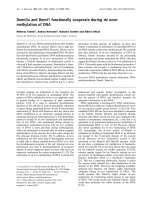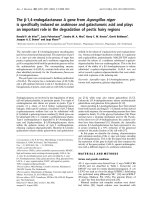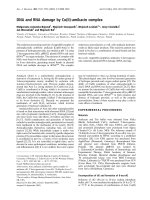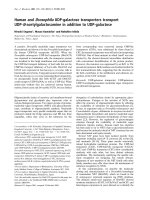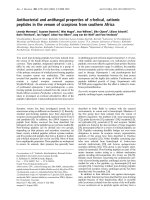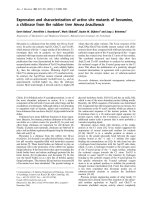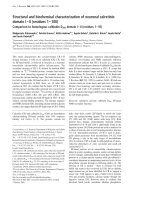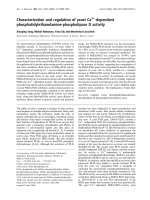Báo cáo y học: "Stress and Childhood Asthma Risk: Overlapping Evidence from Animal Studies and Epidemiologic Research" potx
Bạn đang xem bản rút gọn của tài liệu. Xem và tải ngay bản đầy đủ của tài liệu tại đây (149.5 KB, 8 trang )
ORIGINAL ARTICLE
Stress and Childhood Asthma Risk: Overlapping Evidence
from Animal Studies and Epidemiologic Research
Rosalind J. Wright, MD, MPH
Rapidly expanding evidence increasingly strengthens the evidence linking psychological factors to asthma and allergy expression.
Parallel studies in animals and humans demonstrating the influence of prenatal maternal stress and early caregiving experiences on
the disrupted regulation of defensive biological systems [eg, sympathetic and adrenomedullary (SAM) system and the hypothalamic-
pituitary-adrenocortical (HPA) axis] provide strong proof of concept for this line of research. The consequent altered neuroimmune
responses may influence the expression of immune-mediated disorders such as asthma as well as enhance an individual’s
susceptibility to other environmental factors that may also contribute to asthma risk.
Key words: asthma, childhood, interactions, prenatal, stress
Introduction
Efforts to understand the role of psychological stress in
asthma expression and atopy are currently undergoing
rapid expansion in the context of our increased under-
standing of both the neurobiology of stress and asthma
pathophysiology,
1
as well as trying to determine why
asthma remains a leading cause of health disparities largely
unexplained by known physical environmental factors.
2,3
Notably, consensus statements by both the National
Academy of Science and the National Institute of
Environmental Health Sciences
4
support the position that
examining disparities in environmental health requires
attention to both environmental hazards and social
conditions.
5
Although a number of theoretical models
explaining health disparities have been proposed, a
psychosocial stress model may offer the greatest pro-
mise.
3,6,7
With an estimated half of all cases diagnosed by age 3
years and two-thirds diagnosed by age 5 years, asthma is a
developmental disease.
8
This developmental framework
presupposes that adverse early-life experiences, including
prenatal exposures, may negatively influence neuroendo-
crine and immune developmental processes relevant to
asthma risk. Although studies of mechanisms by which
perinatal stress may increase the risk of childhood asthma
are only beginning to emerge,
9,10
proof of concept is
provided by drawing from animal studies on the effects of
early-life adversity on stress neurobiology and develop-
ment and more recent human data that parallel the animal
research. This overview provides a framework grounded in
this theoretical rationale and may guide future studies that
examine the mechanisms underlying the role of stress in
asthma development in epidemiologic research.
Neurobiology of Stress
Psychological stressors have been associated with the
activation of the sympathetic and adrenomedullary
(SAM) system and the hypothalamic-pituitary-adrenocor-
tical (HPA) axis (see Wright
1
for an extensive review).
Negative emotional responses disturb the regulation of the
HPA axis and the SAM systems; that is, in the face of
stress, physiologic systems may operate at higher or lower
levels than during normal homeostasis. The disturbed
balance of these systems is relevant to disease. Immune,
metabolic, and neural defensive biologic responses impor-
tant for the short-term response to stress may produce
long-term damage if not checked and eventually termi-
nated.
11
The potential detrimental cost of such accom-
modation to stress has been conceptualized as allostatic
load (ie, wear and tear from chronic under- or overactivity
of the allostatic system). Hormones and neuropeptides
Rosalind J. Wright: Channing Laboratory, Department of Medicine,
Brigham and Women’s Hospital, Harvard Medical School and
Department of Society, Human Development and Health, Harvard
School of Public Health, Boston, MA.
Correspondence to: Dr. Rosalind J. Wright, Channing Laboratory, 181
Longwood Avenue, Boston, MA 02115; e-mail: rosalind.wright@
channing.harvard.edu.
DOI 10.2310/7480.2008.00003
Allergy, Asthma, and Clinical Immunology, Vol 4, No 1 (Spring), 2008: pp 29–36 29
released into the circulation when individuals experience
stress are thought to be involved in regulating both
immunomediated and neurogenic inflammatory processes.
Studies in animals and humans have shown that prenatal
maternal stress and disturbances in early caregiving may
have lasting effects on the stress pathways discussed
above.
12–14
Critical Developmental Periods
Prenatal Maternal Stress and Perinatal Physiologic
Programming
Studies suggest that characteristics of the in utero
environment, independent of genetic susceptibility, influ-
ence fetal development, including immune development.
The concept that nongenetic factors act early in life to
permanently organize or imprint physiologic systems is
known as perinatal programming.
15
The HPA axis
seems particularly susceptible to early-life programming.
Both nonhuman primate and rodent models of
prenatal stress and early adverse caregiving
13,14,16
have
helped us understand the consequences of similar
experiences in humans.
17,18
Maternal and fetal stress
stimulates placental secretion of corticotropin-releasing
hormone, which, in turn, is elevated in the neonatal
circulation.
19–22
This may stimulate the fetal HPA axis to
secrete glucocorticoids, amplifying fetal glucocorticoid
excess. Although these in utero responses may be adaptive
in the short term, being geared toward coping with
anticipated environmental challenges, ultimately they may
exact a toll in contributing to increased risk of disease in
later life.
15
A well-known key characteristic of HPA axis function-
ing is the marked interindividual variability of responses to
challenge,
23
and the understanding of the relevance of this
neuroendocrine system in human pathophysiology
(including that relevant to asthma) requires the identifica-
tion of the determinants of this variability. Genetic factors,
other in utero and postnatal environmental factors, and
the timing of exposures likely impact the differentiation of
this response. The notion that the influence of maternal
stress on such physiologic programming may vary based
on an individual’s genetic background is supported by
noted strain differences in hormonal and behavioural
responses to stress in rats and mice.
15
Data suggest that
fetoplacental 11b-hydroxysteroid dehydrogenase, type 2
(11b-HSD2), may play an important role in modulating
the programming effects of prenatal endogenous gluco-
corticoid exposure.
19,24
The type 2 isoform inactivates
cortisol to cortisone, plays a role in the ontogeny of the fetal
pituitary-adrenal axis, and protects the developing fetus
from the adverse effects of circulating maternal glucocorti-
coids.
25
Interestingly, 11b-HSD2 has been colocalized in
human lung tissue and is expressed in human placenta.
26,27
Interperson and interstrain (mouse) variability in the
expression and efficiency of 11b-HSD2 has been demon-
strated, suggesting genetic variability.
28
Glucocorticoid
receptors are also highly expressed in virtually all fetal
tissues from midgestation or earlier.
29
Variants of the
glucocorticoid receptor gene may contribute to interindi-
vidual variability in HPA axis activity and glucocorticoid
sensitivity in response to stress as well.
30
The complexity of the measurement issues related to
prenatal physiologic stress responses is beyond the scope of
this overview. A number of recent reviews provide more
detail.
31,32
Others highlight particular methodologic chal-
lenges and detail strategies for studying these processes
prenatally.
33,34
Also central to consideration of the influence of
antenatal maternal stress on the postnatal development
of children are the putative effects of episodes of such
stress on the fetus. These are beginning to be explored
and documented.
35
Prenatal cortisol dysregulation in
depressed pregnant women has been linked to prematurity
and low birth weight
36
and postpartum depression.
37
Gestational exposure to maternal stress has been shown to
alter the development of humoral immunocompetence in
offspring, as well as their hormonal and immunologic
responses to postnatal stress.
38–41
Evidence in rhesus
monkeys suggests that stress experienced during pregnancy
impacts the infant monkeys’ response to antigens at
birth.
42
In this light, there is also evidence that the asthma
phenotype could be programmed before birth. Both
genetic and environmental factors affecting maturation
of the immune system during pregnancy and early
childhood set the stage for the inflammatory processes
and altered reactivity to stimuli that are characteristic of
chronic asthma. Studies have shown a positive association
between maternal use of antibiotics during pregnancy and
the development of childhood asthma and a negative
association between maternal use of probiotics during
pregnancy and the development of childhood asthma.
43
Others have considered the influence of maternal infec-
tions during gestation on asthma risk.
44–48
Some speculate
that stress triggers hormones in early life, which influence
T helper (Th)2 cell predominance, perhaps through a
direct influence of stress hormones on cytokine produc-
tion,
1,49
although this has not been studied directly to date.
30 Allergy, Asthma, and Clinical Immunology, Volume 4, Number 1, 2008
In particular, alterations in stress-induced maternal
cortisol levels may influence the fetal immune system
development and lead to an increased risk of atopic
disorders, as conceptualized in Figure 1.
In preliminary analyses in our laboratory, we examined
the relationship between diurnal salivary cortisol expres-
sion and total immunoglobulin E (IgE) among 89
pregnant mothers enrolled in the Asthma Coalition on
Community, Environment, and Social Stress (ACCESS)
project, a prospective cohort designed to study the effects
of early-life stress on urban childhood asthma risk.
50
Salivary cortisol was collected five times per day over 3
consecutive days to assess basal awakening response,
morning rise, diurnal slope, and area under the curve.
Total IgE was dichotomized above or below the population
mean (48.95 IU/mL). Repeated measures mixed models
were run controlling for race, income, and weeks pregnant
at the time of cortisol sampling. Higher levels of maternal
total IgE were significantly associated with a flatter diurnal
cortisol slope (p 5 .05). Examination of the cortisol
curves showed that those with higher IgE demonstrated
less of a decline during the evening. Thus, blunted HPA
functioning in pregnant women was related to higher
maternal total IgE expression. Other evidence suggests
that elevated maternal IgE in utero may potentiate fetal
sensitization to allergens and enhance atopic risk in
infancy.
51
Stress-induced altered activity of the maternal
HPA axis may have immunomodulatory effects that
influence expression of IgE during pregnancy, which, in
turn, may have implications for fetal sensitization and
childhood allergy and asthma risk. These findings warrant
further study.
Figure 1. Conceptual model linking
prenatal maternal stress with child-
hood immunity. CNS 5 central ner-
vous system; CRH 5 corticotropin-
releasing hormone; NS 5 nervous
system.
Wright, Stress and Childhood Asthma Risk 31
Early Childhood Caregiving Experience
The early childhood environment and caregiving experience
can also impact these processes.
52–54
Studies in both rodents
and primates have shown that environmental manipula-
tions that increase maternal stress result in elevated cortisol
levels and dysfunctional behaviours in offspring that are
evident later in life.
55–57
In parallel to the animal studies,
evidence linking the social environment and social stress to
regulation of the HPA axis during early development in
humans is also growing.
17
Numerous retrospective studies
in human HPA functioning suggest that increased reactivity
of the HPA system is associated with early-life trauma
58–61
and severe deprivation.
62
Studies of infants and toddlers
have linked maternal depression to dysregulation of the
child’s HPA axis in both cross-sectional
63
and long-
itudinal
64
studies. Other studies of preschoolers and older
children suggest that children’s cortisol levels are positively
correlated with numerous social stresses
65–67
and to broader
family characteristics known to be associated with higher
stress levels (eg, low socio-economic status [SES]).
65
Essex
and colleagues examined the relationships of maternal stress
beginning in infancy and concurrent stress on preschoolers’
(aged 4.5 years) HPA activity and later mental health
outcomes.
68
A cross-sectional analysis revealed that pre-
schoolers exposed to high levels of concurrent maternal
stress had elevated cortisol levels. Longitudinal analyses
showed that concurrently stressed children with elevated
cortisol also had a history of high maternal stress exposure
in infancy. Importantly, children exposed only to high levels
of concurrent or early stress had cortisol levels that did not
significantly differ from those never exposed to stress. Also
of note, further analysis of the specific components of stress
indicated that maternal depression beginning in infancy was
the most potent predictor of children’s cortisol.
In this context, it is notable that our laboratory has also
linked early-life caregiver stress to repeated wheeze
9
and
dysregulation of immune function
10
in a birth cohort
predisposed to atopy. Specifically, caregiver stress assessed
during infancy predicted antigen-specific T-cell prolifera-
tive responses in children at approximately 2 years of age.
10
There is growing evidence that these cytokine patterns are
already present in the first year of life
69
and may have their
roots in utero.
70
Need to Consider Environmental Interactions with
Stress
Another notion that we have explored in an ongoing
Boston cohort is whether there is increased asthma risk in
lower-income urban environments that can be explained,
in part, by a combination of increased contaminant
exposures and greater susceptibility to their effects. It has
long been noted that air pollution, for instance, may be
higher near major roadways, power plants, and industrial
sites, where property values are lower and lower-income
populations reside. Increased life stress among subgroups
living in lower-income neighborhoods has also been
proposed as a primary pathway through which socio-
ecomic position (SEP) impacts health.
7
These observations
suggest that chronic social stressors, such as violence, may
be more prevalent or severe in the same communities
where pollution is elevated, resulting in both greater
exposures and greater susceptibility.
71
Traffic-related air pollution is linked to asthma
exacerbation and respiratory outcomes.
72,73
In the
United States and Europe, children living or attending
school near truck routes and highways show increased
asthma symptoms,
72
hospitalizations,
74
allergic rhinitis,
75
and reduced lung function.
73
Traffic-related pollutants
may also influence etiology.
76
In parallel, chronic stress has been linked to asthma
symptoms in cross-sectional population studies
77
and in
prospective studies linking caretaker stress to infant
wheeze
9
and IgE and immune mediator production.
10
Some evidence indicates that violent events may trigger
asthma episodes.
78
Chronic stress may induce HPA axis
and cortisol dysregulation,
79,80
glucocorticoid resistance,
81
SAM activation, catecholamine production,
82
immune
mediator function, inflammation,
82
and cytokine produc-
tion.
10,83
Finally, stress and pollution impact common
physiologic systems, facilitating synergistic effects; early-
childhood environmental exposures and catecholamines
affect Th1-Th2 balance.
1
For example, studies show that
psychological stress,
84
diesel exhaust, cigarette smoke, and
ozone affect oxidative stress, asthma, and chronic obstruc-
tive pulmonary disease.
85
Traffic-health relationships have been examined using
many traffic indicators,
75,86
with no consensus on which
best capture variability in traffic-related pollution or health
outcomes in different settings. Previous studies have
successfully extrapolated traffic-related exposures from
sampling homes to larger cohorts using predictive land-use
regression (LUR) models.
73,86
LUR shows strong predic-
tive power for intraurban nitric oxide (NO
2
) variability,
87
using traffic and land use characteristics (ie, population
density, major sources).
My research group investigated the potential for
exposure to violence (ETV), as a chronic stressor, to
increase pollution susceptibility.
88
We developed GIS-
32 Allergy, Asthma, and Clinical Immunology, Volume 4, Number 1, 2008
based models to retrospectively estimate residential
exposures to traffic-related air pollution for 413 children
in a community-based pregnancy cohort recruited in East
Boston, Massachusetts, between 1987 and 1993, using
monthly NO
2
measurements for 13 sites collected over 18
years. Merging pollution estimates with questionnaire data
on lifetime ETV (considered here as a chronic stressor)
and prospectively collected repeated measures data on
asthma onset in these urban children, we explored the
hypothesis that stress may enhance the susceptibility to air
pollution in childhood asthma etiology.
After correcting for potential confounders, including
gender, SES, race/ethnicity, tobacco smoke exposure, and
lower respiratory tract illnesses, we found an elevated risk
of asthma with a 1 SD (4.3 ppb) increase in NO
2
exposure
solely among children with above-median violence expo-
sures (odds ratio [OR] 5 1.63; 95% confidence interval
[CI] 5 1.14–2.33; p 5 .03). Among children always living
in the same community, with lesser measurement error,
this association was magnified (OR 5 2.40; 95% CI 5
1.48–3.88; p 5 .0009).
Summary
Evidence from both animal and human studies supports
the notion that HPA functioning and other stress pathways
may be altered by in utero stress and early caregiving
experiences. Both nonhuman primate and rodent models
of early adverse caregiving
13,14,16
have helped us under-
stand the consequences of similar experiences in
humans.
17,18
Disturbed regulation of stress systems (eg,
HPA axis and the SAM system) related to chronic stress
suggests that immune function, which is modulated by
these systems, may also be disrupted in these individuals.
This, in turn, may have implications for asthma develop-
ment.
89
Future studies that incorporate these strands of
overlapping scholarship and strategies for studying stress
reactivity during pregnancy, infancy, and early childhood
are needed to continue to elucidate the mechanisms
underlying the links between stress and asthma develop-
ment. Specifically, these studies need to address how fetal
exposure to stress may influence human immune and
neuroendocrine development, whether such effects are
independent of postnatal exposures, and how these
pathways may, in turn, influence asthma development.
The role of exposure timing and critical windows of
development will need to be considered in these study
designs. By so doing, we will be better able to translate this
research into more effective intervention strategies and
treatments.
Moreover, given the potential spatial covariance across
exposures, and because stress and physical environmental
factors (eg, pollution) may influence common physiologic
pathways (ie, oxidative stress) and health outcomes (ie,
respiratory disease),
1
stronger methods are needed to
disentangle their effects and investigate synergies.
3,7,90
Similar hypotheses could be developed in relation to stress
and tobacco exposure.
References
1. Wright RJ. Stress and atopic disorders. J Allergy Clin Immunol
2005;116:1301–6.
2. Gold DR, Wright RJ. Population disparities in asthma. Annu Rev
Public Health 2005;26:1–25.
3. Wright RJ, Fisher EB. Putting asthma into context: influences on
risk, behavior, and intervention. In: Kawachi I, Berkman LF,
editors. Neighborhoods and health. New York: Oxford University
Press; 2003. p. 233–62.
4. Summary of the Symposium on Genetic Variation and Gene
Environment Interaction in Human Health and Disease. National
Institute of Environmental Health Sciences (NIEHS), National
Human Genome Research Institute (NHGRI) and National Institute
of Alcohol Abuse and Alcoholism (NIAAA). Available at: http://
www.niehs.nih.gov/health/topics/science/gene-env/docs/gesymp03.pdf
(accessed November 30, 2007).
5. Committee on Assessing Interactions Among Social, Behavioral
and Genetic Factors in Health. Genes, behavior, and the social
environment: moving beyond the nature/nurture debate.
Hernandez LM, Blazer DG, editors. Washington (DC): Institute
of Medicine of the National Academies; 2006. p. 109–31.
6. Dressler WW, Oths KS, Gravlee CC. Race and ethnicity in public
health research: models to explain health disparities. Annu Rev
Anthropol 2005;34:231–52.
7. Gee GC, Payne-Sturges DC. Environmental health disparities: a
framework integrating psychosocial and environmental concepts.
Environ Health Perspect 2004;112:1645–53.
8. Reed CE. The natural history of asthma. J Allergy Clin Immunol
2006;118:543–8.
9. Wright RJ, Cohen S, Carey V, et al. Parental stress as a predictor of
wheezing in infancy: a prospective birth-cohort study. Am J Respir
Crit Care Med 2002;165:358–65.
10. Wright RJ, Finn PW, Contreras JP, et al. Chronic caregiver stress
and IgE expression, allergen-induced proliferation and cytokine
profiles in a birth cohort predisposed to atopy. Am Acad Allergy
Asthma Immunol 2004;113:1051–7.
11. McEwen BS. Protective and damaging effects of stress mediators:
the good and bad sides of the response to stress. Metab Clin Exp
2002;51(6 Suppl 1):2–4.
12. Meaney MJ, Szyf M. Maternal care as a model for experience-
dependent chromatin plasticity? Trends Neurosci 2005;28:456–63.
13. Sanchez MM, Ladd CO, Plotsky PM. Early adverse experience as a
developmental risk factor for later psychopathology: evidence from
rodent and primate models. Dev Psychopathol 2001;13:419–49.
14. Sanchez MM. The impact of early adverse care on HPA axis
development: nonhuman primate models. Horm Behav 2006;50:
623–31.
Wright, Stress and Childhood Asthma Risk 33
15. Welberg L, Seckl J. Prenatal stress, glucocorticoids and the
programming of the brain. J Neuroendocrinol 2001;17:113–28.
16. Sanchez MM, Noble PM, Lyon CK, et al. Alterations in diurnal
cortisol rhythm and acoustic startle response in nonhuman
primates with adverse rearing. Biol Psychiatry 2005;15:373–81.
17. Gunnar MR, Donzella B. Social regulation of the cortisol levels in
early human development. Psychoneuroendocrinology 2002;27:
199–220.
18. Gunnar MR. Quality of early care and buffering of neuroendocrine
stress reactions: potential effects on the developing human brain.
Prev Med 1998;27:208–11.
19. Seckl J. Glucocorticoids, feto-plaental 11-beta-hydroxysteroid
dehydrgenase type 2, and the early life origins of adult disease.
Steroids 1997;62:89–94.
20. Seckl JR. Glucocorticoid programming of the fetus: adult
phenotypes and molecular mechanisms. Mol Cell Endocrinol
2001;185:61–71.
21. Reinisch JM, Simon NG, Karwo WG, et al. Prenatal exposure to
prednisone in humans and animals retards intra-uterine growth.
Science 1978;202:436–8.
22. Goland RS, Jozak S, Warren WB, et al. Elevated levels of umbilical
cord plasma corticotropin-releasing hormone in growth-related
fetuses. J Clin Endocrinol Metab 1993;77:1174–9.
23. Marsland AL, Manuck SB, Fazzari TV, et al. Stability of individual
differences in cellular immune responses to acute psychological
stress. Psychosom Med 1995;57:295–8.
24. Edwards C, Benediktsson R, Lindsay R, Seckl J. Dysfunction of
placental glucocorticoid barrier—link between fetal environment
and adult hypertension. Lancet 1993;341:355–7.
25. Krozowski Z, Li KXZ, Koyama K, et al. The type I and type II 11
beta-hydroxysteroid dehydrogenase enzymes. J Steroid Mol Biol
1999;69:391–401.
26. Brown RW, Diaz R, Robson A, et al. The ontogeny of 11beta-
hydroxysteroid dehydrogenase type 2 and mineralocorticoid
receptor gene expression reveal intricate control of glucocorticoid
action in development. Endocrinology 1996;137:794–7.
27. Hirasawa G, Sasano H, Takahashi K, et al. Colocalization of
11beta-hydroxysteroid dehydrogenase type II and mineralocorti-
coid receptor in human epithelia. J Clin Endocrinol Metab 1997;
82:3859–63.
28. Stewart P, Rogerson F, Mason J. Type 2, 11beta-hydroxysteroid
dehydrogenase messenger RNA and activity in human placenta and
fetal membranes: its relationship to birth weight and putative role
in fetal steroidogenesis. J Clin Endocrinol Metab 1995;80:885–90.
29. Diaz R, Brown RW, Seckl JR. Ontogeny of mRNAs encoding
glucocorticoid and mineralocorticoid receptors and 11beta-
deoxysteroid dehydrogenase in prenatal rat brain development
reveal complex control of glucocorticoid action. J Neurosci 1998;
18:2570–80.
30. Wust S, Van Rossum EF, Federenko IS, et al. Common
polymorphisms in the glucocorticoid receptor gene are associated
with adrenocortical responses to psychosocial stress. J Clin
Endocrinol Metab 2004;89:565–73.
31. de Weerth C, Buitelaar JK. Physiological stress reactivity in human
pregnancy—a review. Neurosci Biobehav Rev 2005;29:295–312.
32. Monk C, Myers MM, Sloan RP, et al. Effects of women’s stress-
elicited physiological activity and chronic anxiety on fetal heart
rate. J Dev Behav Pediatr 2003;24:32–8.
33. Harville EW, Savitz DA, Dole N, et al. Patterns of salivary cortisol
secretion in pregnancy and implications for assessment protocols.
Biol Psychiatry 2007;74:85–91.
34. Jones NM, Holzman CB, Zanella AJ, et al. Assesing mid-trimester
salivary cortisol levels across three consecutive days in pregnant
women using an at-home collection protocol. Paediatr Perinatal
Epidemiol 2006;20:425–37.
35. DiPietro JA, Cotigan KA, Gurewitsch ED. Fetal response to
induced maternal stress. Early Hum Dev 2003;74:125–38.
36. Field T, Hernandez-Reif M, Diego M, et al. Prenatal cortisol,
prematurity and low birthweight. Infant Behav Dev 2006;29:268–
75.
37. Nierop A, Bartsikas A, Zimmerman R, Ehlert U. Are stress-induced
cortisol changes during pregnancy associated with postpartum
depressive symptoms? Psychosom Med 2006;68:931–7.
38. Barker DJ. A new model for the origins of chronic disease. Med
Health Care Philos 2001;4:31–5.
39. Hales CN, Barker DJP, Clark PMS, et al. Fetal and infant growth
and impaired glucose tolerance at age 64. BMJ 1991;303:
1019–22.
40. Levitt NS, Lindsay RS, Holmes MC, Seckl JR. Dexamethasone
in the last week of pregnancy attenuates hippocampal glucocorti-
coid receptor gene expression and elevates blood pressure in
the adult offspring in the rat. Neuroendocrinology 1986;39:
1299–305.
41. Egliston K-A, McMahan C, Austin M-P. Stress in pregnancy and
infant HPA axis function: conceptual and methodological issues
relating to the use of salivary cortisol as an outcome measure.
Psychoneuroendocrinology 2007;32:1–13.
42. Coe CL, Lubach GR, Karaszewski JW. Prenatal stress and immune
recognition of self and nonself in the primate neonate. Biol
Neonate 1999;76:301–10.
43. Kallioma
¨
ki M, Salminen S, Arvilommi H, et al. Probiotics in
primary prevention of atopic disease: a randomized placebo-
controlled trial. Lancet 2001;357:1076–9.
44. Hughes CH, Jones RC, Wright DE, Dobbs FF. A retrospective
study of the relationship between childhood asthma and
respiratory infection during gestation. Clin Exp Allergy 1999;29:
1378–81.
45. Xu B, Pekkanen J, Jarvelin MR, et al. Maternal infections in
pregnancy and the development of asthma among offspring. Int J
Epidemiol 1999;28:723–7.
46. McKeever T, Lewis SA, Smith C, Hubbard R. The importance of
prenatal exposures on the development of allergic disease: a birth
cohort study using the West Midlands General Practice Database.
Am J Respir Crit Care Med 2002;166:827–32.
47. Calvani M, Alessandri C, Sopo SM, et al. Infections and uterus
related complications during pregnancy and development of atopic
and nonatopic asthma in children. Allergy 2004;59:99–106.
48. Macaubas C, De Klerk NH, Holt BJ, et al. Association between
antenatal cytokine production and the development of atopy and
asthma at age 6 years. Lancet 2003;362:1192–7.
49. von Hertzen LC. Maternal stress and T-cell differentiation of the
developing immune system: possible implications for the devel-
opment of asthma and atopy. J Allergy Clin Immunol 2002;109:
923–8.
50. Wright RJ, Franco-Suglia S, Staudenmayer JW, et al. AJRCCM
2007. Blunted cortisol response predicts increased total IgE in
pregnant mothers enrolled in an urban asthma birth-cohort:
34 Allergy, Asthma, and Clinical Immunology, Volume 4, Number 1, 2008
Project ACCESS. Presented at the International Conference of the
American Thoracic Society; 2007; San Francisco, CA.
51. Liu C-A, Wang C-L, Chuang H, et al. Prenatal prediction of infant
atopy by maternal but not paternal total IgE levels. J Allergy Clin
Immunol 2003;112:899–904.
52. Vallee M, Mayo W, Dellu F, et al. Prenatal stress induces high
anxiety and postnatal handling induces low anxiety in adult
offspring: correlation with stress-induce corticosterone secretion. J
Neurosci 1997;17:626–36.
53. Liu D, Diorio J, Tannenbaum B, et al. Maternal care, hippocampal
gluccocorticoid receptors, and hypothalamic-pituitary-adrenal
response to stress. Science 1997;277:1659–62.
54. Anisman H, Zaharia MD, Meaney MJ, Merali Z. Do early-life
events permanently alter behavioral and hormonal responses to
stressors? Int J Dev Neurosci 1998;16:149–64.
55. Caldji C, Diorio J, Meaney MJ. Variations in maternal care in
infancy regulate the development of stress reactivity. Biol
Psychiatry 2000;48:1164–74.
56. Coplan J, Andrews MW, Rosenblum LA, et al. Persistent elevations
of cerebrospinal fluid concentrations of corticotropin-releasing
factor in adult nonhuman primates exposed to early-life stressors:
implications for the pathophysiology of mood and anxiety
disorders. Proc Natl Acad Sci U S A 1996;93:1619–23.
57. Francis DD, Caldji C, Champagne F, et al. The role of
corticotropin-releasing factor-norepinephrine systems in mediat-
ing the efects of early experience on the development of be-
havioral and endocrine responses to stress. Biol Psychiatry 1999;46:
1153–66.
58. Cicchetti D, Rogosch FA. Diverse patterns of neuroendocrine
activity in maltreated children. Dev Psychopathol 2001;13:677–93.
59. DeBellis MD, Baum AS, Birmaher B, et al. Developmental
traumatology, part 1: biological stress systems. Biol Psychiatry
1999;9:1259–70.
60. Heim C, Newport DJ, Heit S, et al. Pituitary-adrenal and
autonomic responses to stress in women after sexual and physical
abuse in childhood. JAMA 2000;284:592–7.
61. Kaufman J, Birmaher B, Perel J, et al. The corticotropin-releasing
hormone challenge in depressed abused, depressed nonabused, and
normal control children. Biol Psychiatry 1997;42:669–79.
62. Gunnar MR, Bruce J, Hickman SE. Salivary cortisol response to
stress in children. Adv Psychosom Med 2001;22:52–60.
63. Field T. Monographs of the society for research in child
development, Vol 59, No. 21. The development of emotion
regulation: Biological and behavioral considerations 1994; p. 208–
227.
64. Hessl D, Dawson G, Frey K, et al. A longitudinal study of
children of depressed mothers: psychobiological findings related
to stress. In: Hann DM, Huffman LC, Lederhendler KK,
Minecke D, editors. Advancing research on developmental
plasticity: integrating the behavioral sciences and the neuros-
ciences of mental health. Bethesda (MD): National Institutes of
Mental Health; 1998.
65. Lupien SJ, King S, Meaney MJ, McEwen BS. Child’s stress
hormone levels correlate with mother’s socioeconomic status and
depressive state. Biol Psychiatry 2000;48:976–80.
66. Schmidt LA, Fox NA, Rubin KH, et al. Behavioral and
neuroendocrine responses in shy children. Dev Psychobiol 1997;
30:127–40.
67. Tout K, de Haan M, Campbell EK, Gunnar MR. Social behavior
correlates of cortisol activity in child care: gender differences and
time-of-day effects. Child Dev 1998;69:1247–62.
68. Essex MJ, Klein MH, Cho E, Kalin NH. Maternal stress beginning
in infancy may sensitize children to later stress exposure: effects on
cortisol and behavior. Biol Psychiatry 2002;52:776–84.
69. Lemanske RF. Issues in understanding pediatric asthma: epide-
miology and genetics. J Allergy Clin Immunol 2002;109 Suppl:
S521–4.
70. Miller RL, Ginger LC, Bell CA, et al. Prenatal exposure, maternal
sensitization, and sensitization in utero to indoor allergens in an
inner-city cohort. Am J Respir Crit Care Med 2001;164:995–1001.
71. Wright RJ. Health effects of socially toxic neighborhoods: the
violence and urban asthma paradigm. Clin Chest Med 2006;27:
413–21.
72. Brauer M, Hoek G, Van Vilet P, et al. Air pollution from traffic
and the development of respiratory infections and asthmatic and
allergic symptoms in children. Am J Respir Crit Care Med 2002;
166:1092–8.
73. Brunekreef B, Janssen NA, Hartog J, et al. Air pollution from truck
traffic and lung function in children living near motorways.
Epidemiology 1997;8:298–303.
74. Lin M, Chen Y, Villeneuve P, et al. Gaseous air pollutants and asthma
hospitalization of children with low household income in
Vancouver, British Columbia, Canada. Am J Epidemiol 159:294–303.
75. Duhme H, Weiland SK, Keil U, et al. The association between self-
reported symptoms of asthma and allergic rhinitis and self-
reported traffic density on street of residence in adolescents.
Epidemiology 1996;76:578–82.
76. Gordian ME, Haneuse S, Wakefield J. An investigation of the
association between traffic exposure and the diagnosis of asthma in
children. J Exp Sci Environ Epidemiol 2006;16:49–55.
77. Oh Y-M, Kim YS, Yoo SH, et al. Association between stress and
asthma symptoms: a population-based study. Respirology 2004;93:
63–8.
78. Wright R, Steinbach S. Violence: an unrecognized environmental
exposure that may contribute to greater asthma morbidity in high risk
inner-city populations. Environ Health Perspect 2001;109:1085–9.
79. Kirschbaum C, Helhammer DH. Salivary cortisol in psychoneur-
oendocrine research: recent developments and applications.
Psychoneuroendocrinology 1994;19:313–33.
80. Seeman TE, McEwen BS. Impact of social environment characteristics
on neuroendocrine regulation. Psychosom Med 1996;58:459–71.
81. Miller GE, Ritchey AK, Cohen S. Chronic psychological stress and
regulation of pro-inflammatory cytokines: a glucocorticoid-
resistance model. Health Psychol 2002;21:531–41.
82. Glaser R, Kiecolt-Glaser JK. Stress-induced immune dysfunction:
implications for health. Nat Immunol 2005;5:243–51.
83. Chen E, Fisher EB, Bacharier LB, Strunk RC. Socioeconomic
status, stress, and immune markers in adolescents with asthma.
Psychosom Med 2003;65:984–92.
84. Epel E, Blackburn E, Lin J, et al. Accelerated telomere shortening in
response to life stress. Proc Natl Acad Sci U S A 2004;101(49):17312–5.
85. Rahman I, MacNee W. Oxidative stress and regulation of
glutathione in lung inflammation. Eur Respir J 2000;16:534–54.
86. Brauer M, Hoek G, van Vliet P, et al. Estimating long-term average
particulate air pollution concentrations: application of traffic
indicators and geographic information systems. Epidemiology
2003;14:228–39.
Wright, Stress and Childhood Asthma Risk 35
87. Hochadel M, Heinrich J, Gehring U, et al. Predicting long-term
average concentrations of traffic-related air pollutants using GIS-
based information. Atmospheric Environment 2006;40:542–53.
88. Clougherty J, Levy JI, Kubzansky LD, et al. The effects of traffic-
related air pollution and exposure to violence on urban asthma
etiology. Environ Health Perspect 2007;115:1140–6.
89. Wright RJ, Cohen RT, Cohen S. The impact of stress on the
development and expression of atopy. Curr Opin Allergy Clin
Immunol 2004;5:23–9.
90. O’Neill MS, Jerrett M, Kawachi I, et al. Health, wealth, and air
pollution: advancing theory and methods. Environ Health Perspect
2003;111:1861–70.
36 Allergy, Asthma, and Clinical Immunology, Volume 4, Number 1, 2008

